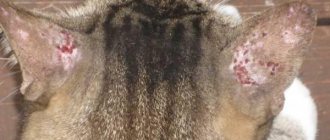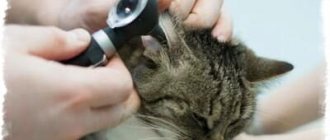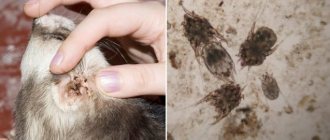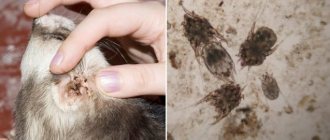Flea dermatitis in cats is one of the most common problems faced by lovers of these animals and from which not a single pet, even a carefully groomed pet, is immune. A similar reaction occurs as a result of an allergy to substances contained in the saliva of blood-sucking parasites. The initial manifestations of the disease can be noticed within ten to fifteen days after the flea bite, and the insects themselves may no longer be on the animal’s body by this time. It has been noticed that a cat with hypersensitive skin can react with a case of dermatitis after just two, or even one, flea bite. In this case, it is necessary to begin treatment immediately before the disease spreads to large areas of the body.
What is flea dermatitis?
Dermatitis is manifested by inflammation of the skin resulting from exposure to an irritant, that is, they are considered allergic diseases. For flea dermatitis to occur, it is not at all necessary that the pet be covered in fleas, since a couple of bites from random insects are often enough for its development. Young cats between nine months and three years of age, as well as those with short hair or hairless breeds, are considered to be most sensitive to such a reaction.
Up to two dozen different allergens can be simultaneously present in a flea's saliva, one of which is likely to lead to an allergic reaction.
The disease develops as follows:
- flea saliva containing the allergen after a bite gets on the skin or under the skin of the cat;
- the allergen penetrates the layers of the epidermis;
- subsequently it penetrates into the lymph;
- Together with the lymph, the allergen spreads throughout the animal’s body;
- in response, cells of the immune system initiate a protective reaction.
It has been noticed that manifestations of dermatitis occur not only at the internal level; quite quickly they also manifest themselves in the form of external rashes, which quickly progress and, if urgent measures are not taken, cause significant discomfort to the cat and even change its behavior.
Diagnostics
Typically, the diagnosis is made based on a complete examination and information received from the animal's owners. You can see the flea bites in the photo. If a specialist finds signs of an inflammatory reaction and a myriad of fleas, then the diagnosis can be considered confirmed.
When diagnosing, flea bite marks on a cat’s skin are especially important. Unfortunately, not all animals have them clearly visible, since the bites are best seen in sensitive cats. In addition, flea feces are very useful in diagnosis. How can they be distinguished from ordinary dirt, which can even be found on the skin of a domestic cat? This is done very simply.
First, collect “waste” from life using the method described above with a large sheet of paper. Then throw the collected grains into a glass of clean water. If the “grain” appeared on the cat as a result of the vital activity of fleas, then in the water it will disperse approximately like potassium permanganate.
But all this is only indirect “evidence”. To accurately detect the presence of flea dermatitis, it is necessary to resort to an allergy skin test. To do this, the veterinarian shaves a small area of skin on the cat's skin. The area is thoroughly wiped with an alcohol swab, and then a special allergen is injected there. If the area where the drug was injected becomes inflamed, the diagnosis is considered confirmed.
But at present, a method for detecting flea dermatitis by the presence of specific antibodies in the blood has already been developed and is actively used in practice. This technique is the key to 100% diagnostic accuracy.
Symptoms of flea dermatitis in cats
An allergic reaction caused by flea dermatitis cannot have a long latent period; diseases of this kind appear quickly and are quite pronounced.
The cat's behavior will begin to change, it will become restless, and upon careful examination of your pet, you can find the following:
- severe itching in a cat causes the animal to constantly itch; scratching in certain places with rashes can merge into limited weeping areas;
- changes in character are noticeable, the cat becomes restless, nervous, and may lose interest in food;
- in areas with rashes, hair loss, deep scratches and redness are observed;
- fleas and traces of their vital activity in the form of dark feces can be found on the skin;
- the rapid development of the disease leads to the formation of scabs in areas of scratching;
- the addition of a secondary infection threatens inflammation with purulent discharge.
A disease such as flea dermatitis can have an acute form, which can become chronic. The most affected areas of the skin are those located on the abdomen, around the ears, and on the back, and they tend to increase and gradually cover more and more new areas. If dermatitis occurs in a chronic form, then exacerbations of the disease are most often observed in the summer.
Mechanism of infection
Did you know that, according to numerous testimonies from veterinarians, in 90% of cases, the majority of skin lesions in their patients are caused by representatives of the blood-sucking order? For some reason, many owners zealously deny the presence of fleas on their four-legged pets, which causes bewilderment among experienced specialists. Owners of small dogs, who “relieve themselves” in a litter box at home, like cats, especially suffer from this misconception. In their opinion, if a pet practically never appears on the street, then this unpleasant problem has nowhere to come from. It's time to dispel dangerous misconceptions.
The flea is a hematophagous insect and, as you probably know, they feed not only on the blood of animals, but also on people. Sensitive tiny insects are able to penetrate apartments and houses:
For the most part, you don't have to be the owner of a furry friend to attract a flea's attention. Without even meaning to, you yourself bring a parasite into your home, for example, on your clothes or dirty shoes.
As a rule, blood-sucking insects hide:
- in sofas;
- mattresses;
- in dust;
- under the parquet;
- in tile cracks;
- behind the baseboards;
- behind the wallpaper and in other secluded corners.
Almost the entire population of tiny bloodsuckers consists of larvae. For a whole year they exist unnoticed in human homes, waiting for their finest hour. And although the main period of outrage of insatiable creatures is considered to be spring, summer and autumn, it is the long stay in the pronymph (pupa) stage that makes these insects very viable and increases the likelihood of flea infestation even in winter.
As you have already understood: fleas are extremely tenacious and dexterous creatures. If a doctor suspects a tailed couch potato is infected with parasites, do not be reckless and deny the diagnosis.
Kinds
Allergic flea dermatitis in cats can occur with varying intensity and some differences in the symptoms shown. Based on these features, the disease is classified into three types:
- Sharp look . Characterized by severe skin itching.
- Subacute appearance . It is an intermediate stage between the acute nature and the transition of the disease to a chronic form.
- Chronic appearance . It is characterized by the formation of nodules on the skin, also accompanied by itching. On damaged skin, hair loss occurs with the appearance of bald areas.
The acute form of flea dermatitis in cats can quickly become chronic, which occurs in the absence of timely treatment or if it is carried out incorrectly. The disease will return until the correct way to eliminate it is found.
Consequences of infection
For some reason, some owners are in no hurry to show their constantly scratching dog to a doctor. Unfortunately, in addition to the above-mentioned flea dermatitis with all the ensuing skin irritations and restless behavior of the pet, small bloodsuckers will cause much more serious damage to the health of a mustachioed pet:
- Chronic form. This type of allergy is characterized by constant relapses, provoked by the owner’s connivance towards the problem and unwillingness to treat the pet well. In the end, insect bites will no longer be necessary for painful manifestations.
- Anemia. Some insensitive dogs do not react in any way to the presence of fleas, which, by the way, multiply at lightning speed. For your information, about 70 females per day are capable of sucking about 1 ml of blood, imagine what will happen if they multiply greatly. Often, after being infected by dangerous flukes, dogs, especially representatives of small breeds, suffer from posthemorrhagic anemia.
- Cucumber tapeworm. Another name for this dangerous disease is dipylidia. Hematophages are spreaders of this serious disease, which also affects humans. The dog endlessly licks the itchy spot and accidentally swallows annoying parasites. The causative agent of the disease penetrates the intestines of the animal along with the insect that previously swallowed the larva of a dangerous worm. An adult reaches a length of one meter. Cestodes developing in the intestines absorb nutrients and irritate the internal walls. Their vital activity leads to intestinal bleeding, obstruction and volvulus, which, in turn, will most likely lead to the death of the animal.
Who is most susceptible?
Despite the fact that flea dermatitis is considered a fairly common form of allergy and is seasonal, not all animals suffer from this disease. For many of them, flea bites pass without a trace, causing only anxiety from the direct bite and not causing flea dermatitis in the cat. Cat breeds with short hair or completely hairless are more predisposed to such a reaction to substances contained in the saliva of parasites.
Particular attention should be paid to your pets during the warm season; it is during this period that the possibility of flea bites increases. Moreover, for this it is not at all necessary to be on the street; the owners themselves can bring them home on street shoes and infect the pet.
Definition of disease
Cat dermatitis is a disease that manifests itself as a common allergic reaction. The animal becomes a target for the insect in two ways:
- Contact with any street animal, dirty shoes, outerwear.
- Weakening of the immune system and contact with a carrier.
Most often, infection occurs in summer or early autumn.
By piercing the upper layer of the dermis, the flea secretes saliva, which gets inside. Scientists claim that such saliva contains about 15 types of irritants. The substances in its composition contribute to the development of an allergic reaction. Most often, animals with weak immune systems are susceptible to it. Kittens under the age of 1 year also become targets of the disease.
Dermatitis in a cat is a disease that manifests itself as a common allergic reaction.
How to diagnose fleas?
Flea dermatitis can be suspected in a cat based on some specific signs that are easy to detect if you pay close attention to it. You just need to take a closer look at the animal and pay attention to changes in its behavior.
If the flea infestation has not yet reached scale and is at the initial stage, then you can check your cat for their presence as follows:
- Place the cat on a clean sheet of white paper.
- Using a comb or brush, comb the animal's fur in different directions.
- Particles of skin, fur, or small black grains resembling dirt may appear on white paper.
- If these particles are crushed, brown or brown marks remain on the paper.
- These particles are flea feces, and the color confirms that the fleas are feeding on the animal's blood.
Such confirmation serves as direct evidence that the cat has fleas, even if there are no other symptoms of infestation. Only a veterinarian can confirm whether their presence is a cause for dermatitis. It is impossible to independently diagnose the flea form of dermatitis, since completely different diseases that do not depend on the presence of skin parasites often exhibit similar symptoms. If, during examination by a specialist, the diagnosis of flea dermatitis is confirmed, then the animal will be prescribed treatment in accordance with the breed and age of the pet, as well as taking into account the form of development of the disease and the degree of damage. Correct prescriptions will not only stop the external manifestation of the disease, but will also prevent its relapses.
How to identify pathology and distinguish it from others
The flea form of the disease is easy to distinguish from other types of dermatitis, since parasites are present. They can be seen with the naked eye. If you have vision problems, you should use glasses or a magnifying glass, since fleas are very small. In the initial stages of the development of the disease, the neck area is affected, so it is necessary to carefully examine this area, carefully moving the hairs apart.
If fleas are not found in one place, this does not mean that they are not found in another. The fact is that in the initial stages of the disease there are very few parasites, so you need to inspect all areas carefully.
If there are fleas, the cat not only itches, but also tries to bite into the skin. If your pet does this regularly, this is a warning sign.
Photo
As a rule, most cases of flea dermatitis can be easily diagnosed by external signs. If you carefully examine the skin of an animal, it reveals the characteristic manifestations of this skin disease.
So, in a photo taken from the affected area of skin you can see:
- characteristic scratches in the form of bloody deep scratches;
- swelling of the skin with the presence of nodes, blisters, and ulcers;
- areas of skin with excessive dryness;
- redness of the skin with pronounced inflammation;
- purulent discharge may be noticed, which is characteristic of an infection.
Despite the obvious severity of symptoms consistent with the development of flea dermatitis, the final conclusion about the type of disease must be made by a veterinarian. Therefore, treatment of the disease should be carried out under his control and with the help of medications prescribed by him.
Treatment of dermatitis
Drug treatment of flea dermatitis in domestic cats is carried out according to a standard regimen, which involves the use of the following medications:
- drugs with anti-inflammatory effects;
- medicines with antibiotic properties;
- antiphlogistic nonsteroidal drugs.
When treating, you need to focus not only on the choice of medications that can cope with the flea form of dermatitis. It is equally important to create the necessary living conditions for the animal.
Antihistamines
To treat cats with symptoms of flea dermatitis, medications containing calcium sodium thiosulfate and hormones are used. With the help of calcium in the drug, it is possible to reduce vascular permeability, eliminate swelling and reduce itching. However, their disadvantage can be considered some features of application, when their administration involves only intravenous injections, which can only be done by a specialist.
The use of sodium thiosulfate is also carried out only intravenously and strictly in accordance with the prescribed course. Thanks to it, the allergic reaction is stopped, which relieves the cat of disturbing symptoms. Moreover, if you seek help early and start treatment in a timely manner with such a drug, you can completely get rid of allergies.
However, antihistamines occupy a special place in methods of therapy aimed against flea dermatitis. With their help, you can quickly cope with itching, and intended for animals, they do not have a harmful effect on their body. These medications are usually given to your cat for three to five days, after which only your veterinarian can decide whether to continue treatment or stop it. The most effective antihistamine medications for cats are prescribed Suprastin, Tavegil, Diphenhydramine or Zyrtec. Chlorpheniramine, which is taken orally twice a day, 2 ml, copes well with this task.
In some cases, antihistamines are not effective enough against allergies, then it is recommended to treat flea dermatitis using glucocorticosteroids.
Hormonal
Hormonal medications are very often prescribed for severe forms of allergies in animals. Typically, Prednisolone is used for these purposes, starting the course of treatment with a high dose and gradually reducing it. The dosage depends on the weight of the cat and its age, due to which the expected result with the elimination of the symptoms of an allergic reaction occurs in a short time. When carrying out treatment with hormonal drugs, it is necessary to take into account their downside, that is, their adverse effect on the vital processes of the animal’s body. Thus, their use may reduce immunity, disrupt metabolic processes, and complicate the processes of digestion and assimilation of food. It is for this reason that hormonal drugs should be used only if indicated for this type of treatment and not used for a long time.
Often a sick animal is offered local hormonal agents as a cream or ointment. Such a prescription is justified in case of contraindications to the use of systemic drugs.
Purpose of therapy
After making a diagnosis, the doctor will prescribe the necessary treatment for your pet. Follow the recommendations strictly. Destroying fleas and eliminating the consequences of their outrage on a dog’s body is a rather difficult task, and it is almost impossible to rid the animal of hypersensitivity to saliva.
Of course, the appointment will be made by the attending physician, but the owner would also benefit from information about the most effective treatment methods:
- Lethal dose. Today on the market there is a huge number of all kinds of tablets, sprays, powders, drops, collars that destroy bloodsuckers parasitizing on the dog’s body. You can easily get confused among this diversity. An experienced specialist will select the right products based on the animal’s condition and the severity of symptoms. Preparations based on imidacloprid and fipronil are considered the most effective. The active substances enter the flea through the blood of an infected animal, although they are not absolutely harmless to our tailed pets. In any case, adhere to the veterinarian's instructions and strictly follow the instructions.
- Fighting allergies. Depending on the scale of the lesion and the severity of the form, the patient will be prescribed concomitant medications. Injections of gluconate or calcium chloride, sodium thiosulfate, which is also administered intravenously and, in extreme cases, hormonal preoral drugs such as prednisolone. The listed substances are aimed at reducing the development or completely stopping the allergic reaction.
- External means. The veterinarian will also prescribe special ointments and shampoos that will soothe the unbearable itching and make the four-legged patient feel better.
- Deworming. As previously mentioned, fleas are carriers of worms and other helminths, so this item will definitely be included in the prescription.
Please note that antihistamines such as Tavegil, Suprastin and others, as a rule, are ineffective for dogs and competent doctors do not prescribe them.
Video - How to give a cat a pill
Often there is a need to treat a pet with tablets and then the question arises: what is the best way to do this?
To do this, you can use the recommendations of specialists or watch the video:
- Carefully study the instructions for the drug and determine the prescribed dosage.
- Decide on the permissibility of giving the medicine with food or dissolved in water.
- Limit the animal's mobility by wrapping it tightly in a thick blanket or towel.
- Raise the cat's head and open its mouth.
- It should be taken into account that the animal will struggle, so it is necessary to hold it still with your free hand.
- By pressing on the lower jaw, it is necessary to open the mouth. Moreover, if you are supposed to give a pill, the mouth must be opened as wide as possible.
- The tablet is inserted with two fingers, trying to get as far as possible to the root of the tongue.
- You must make sure that the tablet is swallowed. To help with this, you can blow lightly into your cat's nostrils, which will trigger the swallowing reflex.
- Release the cat from the blanket and offer it water.
If the animal is strong enough and actively resists, and the fear of inserting fingers into its mouth turns out to be stronger than the desire to help it, then you can insert the tablet using special plastic tweezers, which can be bought at a veterinary pharmacy.
Top 4 best drops
Drops containing insecticides help achieve the best results in the fight against annoying bloodsuckers. Check out the highest quality, most effective and modern products:
- Bars AVZ. A universal remedy, suitable for both adult dogs and puppies. The protective effect lasts for a month. Does not cause side effects.
- Advantix for large breeds from Bayer. It does not penetrate into the pet’s blood, but remains in the sebaceous glands. Designed for large mature dogs weighing over 25 kg, as well as for growing young animals from seven weeks of age.
- Advantix for medium breeds from Bayer. Does not leave excess oil on the coat, protects against any midges and is considered a hypoallergenic product. It is better to use it together with a flea collar from the same manufacturer.
- Frontline Combo S Merial. It is also not absorbed into the blood and destroys eggs and larvae. Using a special bottle, it is convenient to apply the solution directly while walking.
It is important that after using antiparasitic agents, it is better to put a special collar on the animal, which will prevent the dog from licking the strong-smelling liquid.
Diet
When relieving a pet of the symptoms of an allergic reaction to flea bites, it is necessary to help the body cope with this change in its condition with the help of special nutrition. Thanks to this, the skin healing process will happen faster, and inflammation and itching will disappear. If the cat eats natural food, then it is necessary to add Omega-3 acid, for example, Nordic naturals Omega.
If you prefer dry ready-made food, it is better to use Royal Canin Skin or Econuba Dermatosis. For a while, it is necessary to give up chicken-based food and not give chicken as food, since it is this type of food that most often contributes to allergies.
Description of the problem
Flea dermatitis is an inflammation of the skin that occurs as a result of flea bites and an allergy to the saliva produced. The severity of symptoms does not in all cases depend on the number of fleas; sometimes a few bites are enough. According to statistics, an allergic reaction is the main cause of itching in pets. There is no pronounced seasonality, but symptoms are often observed in summer and autumn.
Drops
To eliminate the discomfort caused by flea dermatitis in cats, you can use special drops designed for this purpose and approved for the treatment of allergies in animals. In this capacity, veterinarians advise using the following types of liquid preparation:
- Essential 6 - with the help of this product, the animal quickly gets rid of itching, and they also serve as a guarantee to prevent repeated cases of infection. An additional advantage is the packaging with a small dosage;
- Stronghold are drops that can be used for adult cats and kittens from three months of age.
Using these remedies, you can get rid of parasites on the animal’s body within 24 hours, thereby it will stop suffering from itching and anxiety.
What should you do first?
In order to prevent further development of the disease, the owner must take a number of actions for the treatment to produce results.
- Examine your pet.
- Heat treat all animal toys.
- Get rid of your cat's old bedding and beds.
- If other animals live in the premises, they must also undergo appropriate treatment.
- Disinfect all carpeted areas in the room.
Some veterinarians recommend initially isolating an animal affected by fleas in a separate room and trying to limit its movement. All furniture, equipment and objects with which the animal interacts should be treated with a special antiparasitic substance.
An infected animal must be isolated from other pets
Powder
You can alleviate the condition of an animal when it develops allergic dermatitis as a result of a reaction to flea bites using powder. Most often, powders such as:
- Tsamaks - has wound-healing properties;
- Synthesis - when applied to damaged skin, accelerates its healing, and also effectively relieves inflammation and swelling.
The combination of components in these powders allows you to quickly cope with a problematic situation.
Collar
Using a collar will not get rid of parasites, but it will protect a clean and healthy animal from their penetration. Most often, the following types can be purchased in veterinary pharmacies:
- Leopard - capable of reliably protecting a cat from fleas for seven months, since its characteristic smell repels parasites;
- Baffo - the impregnation of this collar is distinguished by a large number of anti-parasitic components, but they can only be used on animals older than three months.
You should not assume that using a flea collar does not pose any danger to the animal itself. There are cases, however, so far isolated, that the composition used for impregnation can also cause allergies.
Shampoo
As an effective remedy against fleas, special shampoos can be used, which are presented in a large assortment, namely:
- Kiss shampoo - produced in Sweden, it simultaneously kills insects and moisturizes the skin;
- Rolf Club shampoo is a product considered the most effective against fleas, but its more aggressive composition does not allow its use on animals under three months of age.
Many types of shampoos intended for animals, in addition to getting rid of parasites, gently care for the skin, prevent dryness and flaking, and the coat becomes silky and thicker.
Fighting the disease at home
Traditional medicine is used as alternative treatment methods. However, this method does not exclude the professional prescription of a specialist. Rather, this is regarded only as additional measures to alleviate the condition of a mustachioed patient, but certainly not as a panacea for the disease.
- Soap solution. One of the most popular techniques to relieve itching and remove skin rashes. Essential oils of cedar, tea tree and lavender are mixed in equal proportions with soap foam. The resulting composition is used to treat the animal’s fur before and after bathing. The owner will have to be patient, because the results of such treatment will not appear soon.
- Lotions. Infusions of chamomile, fireweed, celandine, burdock, and plantain will help reduce unpleasant symptoms. Usually a compress is applied to the affected area or the surface of the skin is wiped with a cotton swab soaked in the broth.
- Medicinal ointments. You can also make your own special paste. Take one tablespoon of all the above plants and mix with 400 ml of hay dust brew. The resulting mixture is poured with boiling water and steamed in a “bath” for about 5-7 minutes. Then filter the cake and add about fifteen grams of butter to the liquid and keep it on the fire until the mixture thickens. Then add another 15 grams of glycerin and apply to the damaged areas for a month four times a day.
- Chlorhexidine. Based on this antiseptic, various sprays and shampoos are produced that relieve inflammation, prevent infection and have an antimicrobial effect. It is allowed to use a regular 1-2% pharmaceutical solution. It is enough to gently wipe the inflamed area with a moistened cotton pad.
- Hydrogen peroxide. Popular antimicrobial agent. It is better to buy a 3% solution.
- Nutrition. During the acute stage and until stable remission occurs, the animal can be given hypoallergenic food. But it is better to exclude beef, wheat and fermented milk, which provoke allergies. Suitable natural foods would be: pumpkin, turkey, potatoes.
- Vitamins. Be sure to support the dog’s immunity, which is weakened by the fight against the unfortunate allergen. Here you will still have to consult a doctor, since prescribing supplements to your pet at your own discretion is highly not recommended.
In conclusion, I would like to remind you: if you develop hypersensitivity to flea saliva, it will be impossible to completely get rid of this type of dermatitis. The problem will be relevant until the onset of the first cold weather. Then the temperature outside will become unsuitable for fleas and the insects will go into hibernation.
During the warm season, it is recommended to constantly treat dogs prone to this infection. Try to avoid areas with tall, dry grass, where these obnoxious insects like to settle.
And finally, I would like to note that properly functioning anal glands in a pet directly affect the barrier function of the skin. It is important to regularly maintain and keep the area clean. If it is difficult to do this procedure yourself, seek the help of specialists. If these glands work well, it will be easier for your pet to tolerate flea dermatitis.
Be attentive to your four-legged friends. Do not neglect taking care of their health and bring your animal to the veterinary clinic for examination on time.
Spray
Topical sprays are most suitable for contact allergies and flea dermatitis caused by a reaction to fleas.
- Nartz spray has the advantages of a large volume and the presence of several types of the drug, allowing it to be used in accordance with the age and weight of the animal. It has hypoallergenic properties and can be used from one month of age.
- Front-line spray - due to its sufficient volume, it allows you to extend use up to one and a half years, and one application protects the cat from fleas for up to 40 days.
The use of a spray allows you to relieve the animal from itching and obtain an antibacterial and anti-inflammatory effect.
Traditional methods of treating fleas in cats
You can try to alleviate the animal’s condition and treat flea dermatitis in cats at home using traditional methods that will complement the main treatment with medications. To do this, they often use a composition of equal parts of olive and lavender oils and soapy water. Soak a cotton pad in the solution and apply it to the surface of the skin before and immediately after bathing the cat.
The same effect, eliminating irritation and swelling, as well as relieving itching, can be obtained by rubbing with chamomile decoction.
However, if your veterinarian does not recommend using such methods on your animal, then it is better not to use them.
Treatment of the territory
Some owners, after treating their dog, forget to disinfest the dog. Here are a few simple rules to follow:
- Thoroughly vacuum all areas where the animal is. Don't forget about your car, bed, and carrier. After cleaning, throw away the bag or filter.
- Treat surfaces with insecticidal preparations. Neostomozan or Butox will do. As a rule, one ampoule is diluted in two liters of water; in any case, it is better to follow the instructions on the package.
Accompanying illnesses
Flea dermatitis is dangerous due to its complications, the most common of which are:
- development of atopic dermatitis, ending in the formation of lesions;
- the addition of bacterial infections, accompanied by vomiting, diarrhea and symptoms of fever.
If this happens and the cat’s condition does not improve within a few days, then you should immediately consult a veterinarian. To prevent the development of concomitant diseases and complications, it may be necessary to review and change the prescribed treatment regimen.
Prevention
Today there are no effective remedies that could completely protect against allergies to flea bites. To prevent their pet from suffering from flea dermatitis and its complications, owners must protect it from the possibility of infection.
To do this you should:
- do not allow street walks;
- when traveling to the country, pre-treatment against fleas is necessary;
- in case of high humidity, it is better to reduce walks in the air to a minimum;
- Carry out a thorough monthly inspection of the animal for the presence of fleas, and repeat treatment with drugs that have not expired;
- carry out wet cleaning more often in the room where the cat is;
- treat upholstered furniture and carpets with antiseptic agents;
- When you come home, do not leave dirty shoes in the hallway, but after washing them, put them in the closet.
If your pet has undergone treatment for dermatitis and it was successful, it is recommended that its condition be monitored by a veterinarian for several months. This is necessary for timely action in case of relapse.
Additional Notes
As you can see, a seemingly harmless disease can do serious things. That’s why prevention is “our everything.” The simplest and most effective means of preventing flea infestation is a collar. Today there are dozens of varieties on the market, from a wide variety of companies. Don’t forget to change the collar on time, and your cat will be reliably protected from small bloodsuckers. Insecticidal drops and simple wormwood oil have also worked well, which also repels fleas well; you can use tar soap.
In addition, do not forget to clean the room more often, paying special attention to wet cleaning of the most remote corners of the apartment. In this case, it is very useful to add insecticidal preparations or simple chlorine bleaches in good concentrations to the water for washing floors. This way you are guaranteed to destroy all the larvae, and the flea population will not increase.










